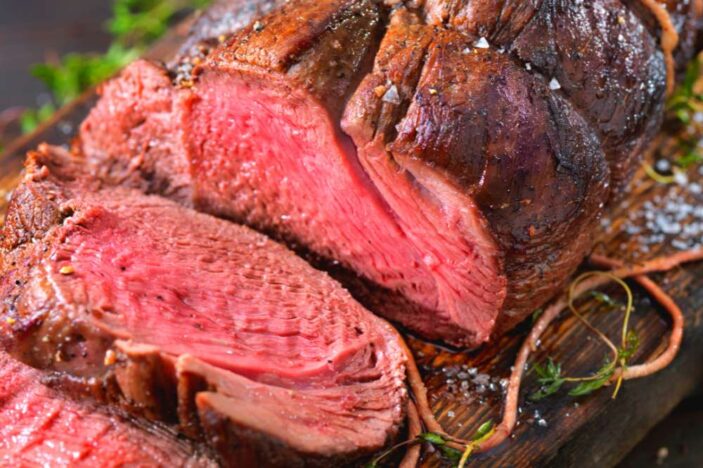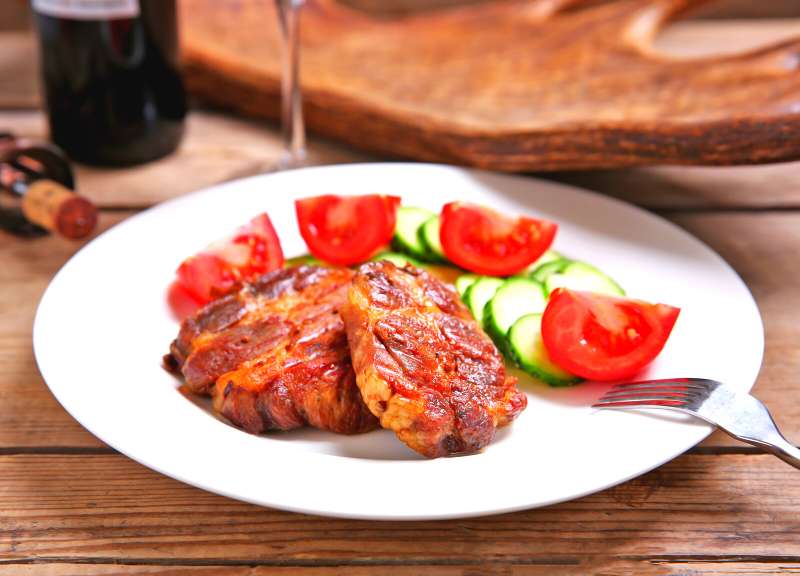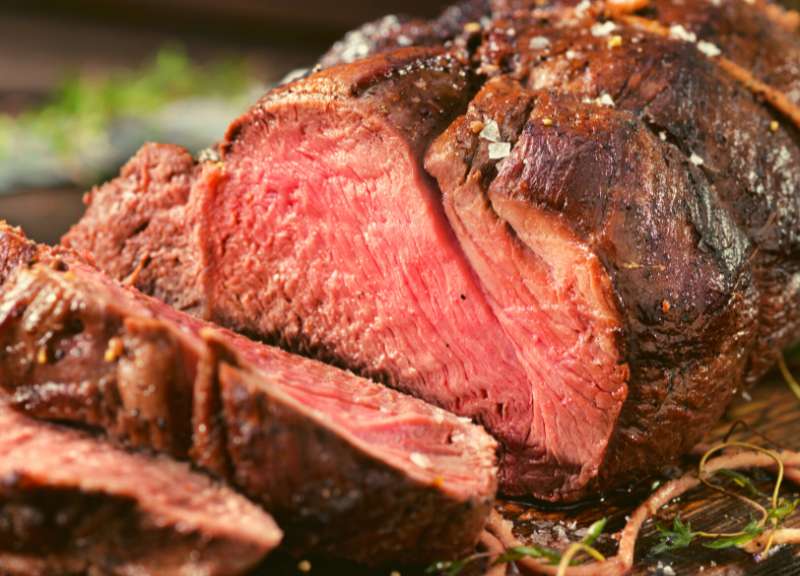Welcome to the world of delicious venison roast! If you’re wondering about the best way to cook venison roast and unlock its full potential, you’ve come to the right place.
Venison roast is a popular choice for meat lovers and a flavorful treat that can elevate your culinary adventures. To ensure your venison roast turns out tender and bursts with flavor, it’s crucial to master the proper cooking techniques.
In this article, we’ll guide you through the steps, from selecting the perfect cut to resting and carving, so you can confidently create a mouthwatering venison roast that will impress even the most discerning taste buds.
Let’s get started!
Choosing The Right Venison Roast

When cooking venison roast, selecting the right cut is essential for a delicious outcome. Different cuts offer distinct qualities and characteristics that can influence the cooking process and final taste.
Let’s explore the factors to consider when choosing your venison roast:
Cuts of Venison Roast
- Shoulder: Known for its marbling and rich flavor, shoulder roast is ideal for slow-cooking methods like braising or pot roasting.
- Loin: Tender and lean, loin roast is perfect for oven roasting or grilling, ensuring a succulent and flavorful result.
- Leg: With its versatility and slightly stronger flavor, leg roast can be prepared using various cooking techniques such as slow cooking or smoking.
Selecting the Best Quality
- Look for deep red or purplish meat with minimal to no odor.
- Choose venison from reputable sources, preferably from trusted hunters or specialty meat suppliers.
- Opt for cuts that are well-trimmed, free of excessive fat, and evenly shaped for even cooking.
Remember, the quality of your venison roast plays a vital role in the overall taste and tenderness of the final dish.
Now that you understand the different cuts and have selected the best quality, let’s move on to the next step: preparing your venison roast for cooking.
No products found.
Related: How To Cook A Beef Roast In An Air Fryer?
Preparing Venison Roast
Preparing venison roast properly before cooking is crucial for maximizing tenderness and flavor. Let’s delve into the essential steps of preparation:
Thawing
Thawing venison roast correctly ensures even cooking throughout. Follow these guidelines for a safe and effective thawing process:
- Place the wrapped venison roast on a tray in the refrigerator and allow it to thaw slowly. This method ensures a steady and controlled thaw without compromising the meat’s quality.
- Estimate the thawing time based on the weight of the roast. Generally, allow approximately 24 hours of refrigeration for every five pounds of venison roast.
- If you need to thaw the roast more quickly, use the cold water method. Submerge the sealed roast in a leak-proof plastic bag, placing it in a bowl of cold water. Change the water every 30 minutes to maintain a safe temperature.
Marinading
Marinating your venison roast can tenderize the meat and enhance its flavor. Consider the following marinade tips:
- Choose a marinade that complements the rich flavor of venison, such as citrus juices, vinegar, herbs, or spices. The acidity in the marinade helps break down the connective tissues, resulting in a more tender roast.
- Place the venison roast and marinade in a sealable bag or container. Ensure the meat is fully coated in the marinade, and if possible, remove any excess air from the bag to improve marinating efficiency.
- Refrigerate the marinating venison roast for the recommended time. The duration will vary depending on the recipe or personal preference, but typically it ranges from 4 to 24 hours. Be sure to turn the roast occasionally to ensure an even distribution of flavors.
No products found.
Seasoning And Rubs
Seasoning venison roast before cooking adds an extra layer of flavor. Here’s how to season your roast effectively:
- Begin by patting the venison roast dry with paper towels to remove any excess moisture. This step allows the seasoning to adhere better to the meat.
- Season the roast with salt and freshly ground black pepper as a base. These basic seasonings enhance the natural flavors of the venison.
- Add herbs, spices, or rubs to enhance the taste further. Popular options include garlic powder, thyme, rosemary, or a pre-made spice rub for game meat.
- Gently press the seasoning mixture onto the surface of the roast, ensuring an even coating. Allow the seasoned roast to rest at room temperature for about 30 minutes before cooking to allow the flavors to penetrate the meat.
These essential preparation steps will set the stage for a tender and flavorful venison roast. Now, let’s move on to the different cooking methods that will bring out the best in your roast.
4 Best Way To Cook Venison Roast

Cooking venison roast requires careful consideration of various methods to achieve the desired tenderness and flavor. Let’s explore some popular cooking techniques:
Oven Roasting
Ah, the classic oven roasting method – reliable, convenient, and oh-so-delicious! Here’s how to cook venison roast in the oven:
- Preheat your oven to the recommended temperature based on the size and cut of your roast. Somewhere between 325°F and 375°F (163°C to 190°C) usually does the trick for most venison roasts.
- Now, take that beautifully seasoned venison roast and give it a prime spot on a rack in a roasting pan. This setup ensures hot air can lovingly circulate the roast, leading to even cooking and that perfect golden-brown crust.
- To keep tabs on your roast’s internal temperature, insert a meat thermometer into the thickest part, carefully avoiding bones or pesky fat. This trusty gadget helps you stay on top of things and ensures accurate cooking.
- Time to let the magic happen! Roast the venison until it reaches your desired level of doneness. For a tender medium-rare result, aim for an internal temperature of 135°F to 140°F (57°C to 60°C). Adjust the cooking time according to your personal preference.
- When your roast emerges from the oven, resist the temptation to dive right in. Give it a well-deserved rest for about 10 to 15 minutes before carving. This short break allows those delightful juices to redistribute throughout the roast, resulting in a moist and tender masterpiece.
Slow Cooking (Crockpot)
Slow-cooking your venison roast in a crockpot yields a tender and succulent result. Here’s how to do it:
- Place the seasoned venison roast in the crockpot and any desired vegetables, such as onions, carrots, and potatoes.
- Add a liquid, such as beef broth, wine, or marinade, to keep the roast moist during the slow cooking.
- Set the crockpot to the desired temperature, usually low or medium-low, and cook the roast for several hours. The exact cooking time depends on the size of the roast and the desired tenderness.
- Check the roast’s internal temperature using a meat thermometer to ensure it reaches a safe minimum internal temperature of 145°F (63°C).
- Once the roast is perfectly cooked, please remove it from the crockpot and let it rest for a few minutes before slicing. This resting period allows the juices to settle and enhances the overall tenderness.
Grilling
Grilling venison roast adds a smoky, charred flavor that perfectly complements the meat. Follow these steps for a delicious grilled roast:
- Preheat your grill to medium-high heat.
- Brush the grill grates with oil to prevent sticking.
- Place the seasoned venison roast on the grill directly over the heat source.
- Cook the roast, turning occasionally, until it reaches the desired level of doneness.
- For medium-rare, aim for an internal temperature of 135°F to 140°F (57°C to 60°C).
- Let the roast rest briefly before carving to retain the juices and ensure optimal tenderness.
Smoking

Smoking venison roast infuses it with a delightful smoky flavor and produces a tender result. Here’s how to smoke your roast:
- Soak wood chips (such as hickory, apple, or cherry) in water for at least 30 minutes before smoking. This prevents them from burning too quickly.
- Preheat your smoker to the desired temperature, usually between 225°F and 250.
- Remove the venison roast from the marinade and pat it dry with paper towels.
- Create a flavorful rub using your preferred combination of herbs, spices, and seasonings.
- Apply the rub generously to the entire surface of the roast, ensuring an even coating.
- Place the seasoned roast on the smoker rack and add the soaked wood chips to the smoker box or directly to the coals.
- Maintain a consistent smoking temperature throughout the cooking process.
- Smoke the roast until it reaches the desired internal temperature. Aim for an internal temperature of 135°F to 140°F (57°C to 60°C) for medium-rare.
- Once the roast reaches the desired doneness, please remove it from the smoker and let it rest for a few minutes before carving.
Using these different cooking methods, you can bring out the best in your venison roast, whether through the succulent oven roasting, the tender slow cooking in a crockpot, the flavorful grilling, or the smoky infusion from smoking.
See also: How To Cook Beef Joints In An Air Fryer?
Resting and Carving
Ah, the tantalizing aroma of a perfectly cooked venison roast fills the air. But hold on. There’s a crucial step before you dig in. Let’s talk about resting and carving your masterpiece:
Resting
- Once your venison roast is cooked to perfection, it’s essential to give it a moment to relax and gather its juices. Here’s why resting is important:
- When you remove the roast from the heat source, tent it loosely with aluminum foil, this gentle covering helps retain the heat and allows the roast to rest without losing its essential juices.
- Rest the venison roast for about 10 to 15 minutes. This short interlude allows the muscle fibers to relax and the juices to redistribute evenly throughout the meat, resulting in a juicier and more tender roast.
- While the roast rests, take this opportunity to prepare any accompanying sauces or side dishes. This way, everything will be perfectly timed to create a memorable dining experience.
Carving
Now comes the exciting part – carving your venison roast like a seasoned pro. Here’s a step-by-step guide to make it a breeze:
- Start by placing the rested roast on a clean cutting board to catch any precious drippings for later use.
- Look for the natural seams or muscle lines on the roast. These lines guide carving and ensure you get the most tender slices.
- Using a sharp carving knife, begin slicing the roast against the grain. This technique helps break down the muscle fibers and enhances the tenderness of each slice.
- Aim for slices of your preferred thickness. Thinner slices offer more surface area for enjoying the flavors, while thicker slices provide a hearty and substantial bite.
- Arrange the beautifully carved slices on a serving platter, and if desired, drizzle some of those flavorful drippings over the top for an extra touch of juiciness and richness.
Conclusion
Now that you know the best ways to cook venison roast, you’re ready to embark on a culinary adventure that will leave your taste buds dancing with delight.
Whether you choose to oven roast, slow cook in a crockpot, grill, or smoke your venison roast, each method offers a unique flavor profile and cooking experience.
Remember, the key to a delicious venison roast is proper seasoning, cooking temperature, and internal temperature monitoring for the desired result.
Resting the roast after cooking allows the flavors to develop and ensures a juicy and tender outcome. And when it’s time to carve, do so confidently and precisely, savoring each succulent slice.
So, gather your ingredients, fire the oven, ignite the grill, or prepare the smoker. Let the tantalizing aroma of venison roast fill your kitchen, and let your creativity shine as you craft a meal that celebrates the natural flavors of this exquisite meat.
Embrace the joy of cooking and relish every bite of your perfectly cooked venison roast. Cheers to culinary excellence and memorable dining experiences!
Happy cooking!
FAQs
Why Is Venison Cooked Rare?
Venison is often cooked rare or medium-rare to preserve its tenderness and prevent it from becoming tough and dry.
Do You Cook Venison The Same As Beef?
While the cooking techniques for venison and beef can be similar, venison has less fat and should be cooked at slightly lower temperatures and for less time to prevent it from drying out.
What Herbs Go Well With Venison?
Herbs such as rosemary, thyme, sage, juniper berries, and bay leaves complement the rich flavors of venison.
How To Slow-Cook Venison Roast In The Oven?
To slow-cook venison roast in the oven, place it in a covered roasting pan with liquid (such as broth or marinade), set the oven temperature to low (around 275°F), and cook for several hours until tender.
How To Keep A Venison Roast Moist?
To keep a venison roast moist, marinate it before cooking, baste it with a flavorful liquid, and avoid overcooking it to prevent dryness.
Last update on 2025-07-01 / Affiliate links / Images from Amazon Product Advertising API
